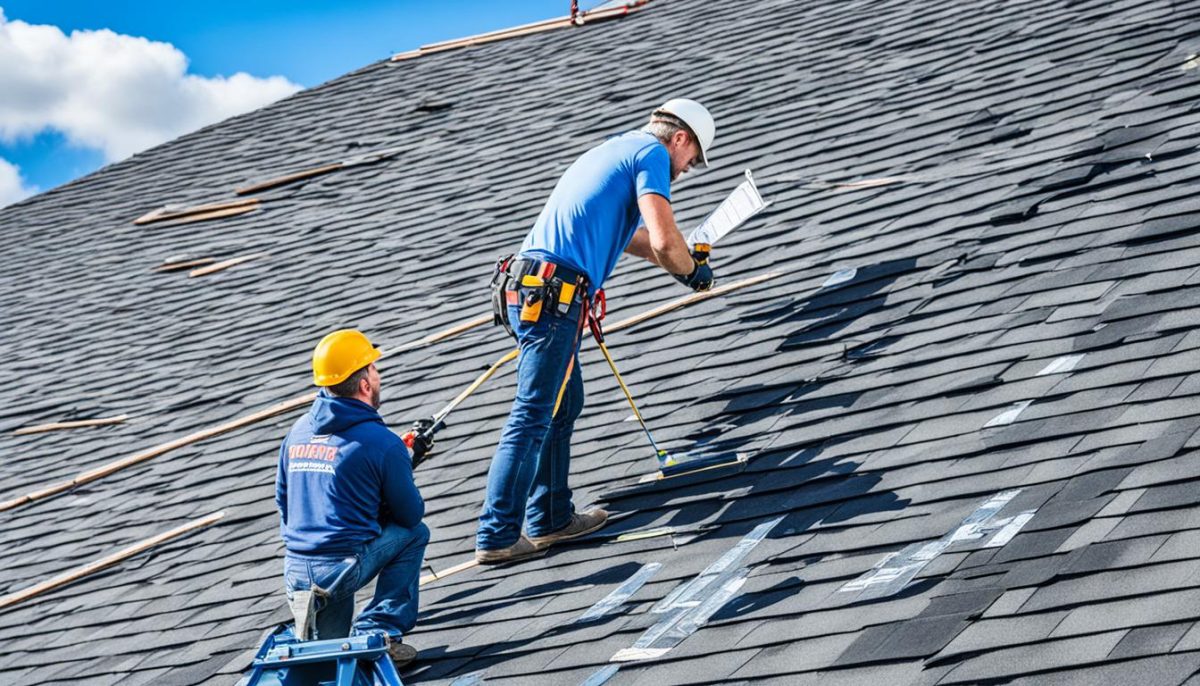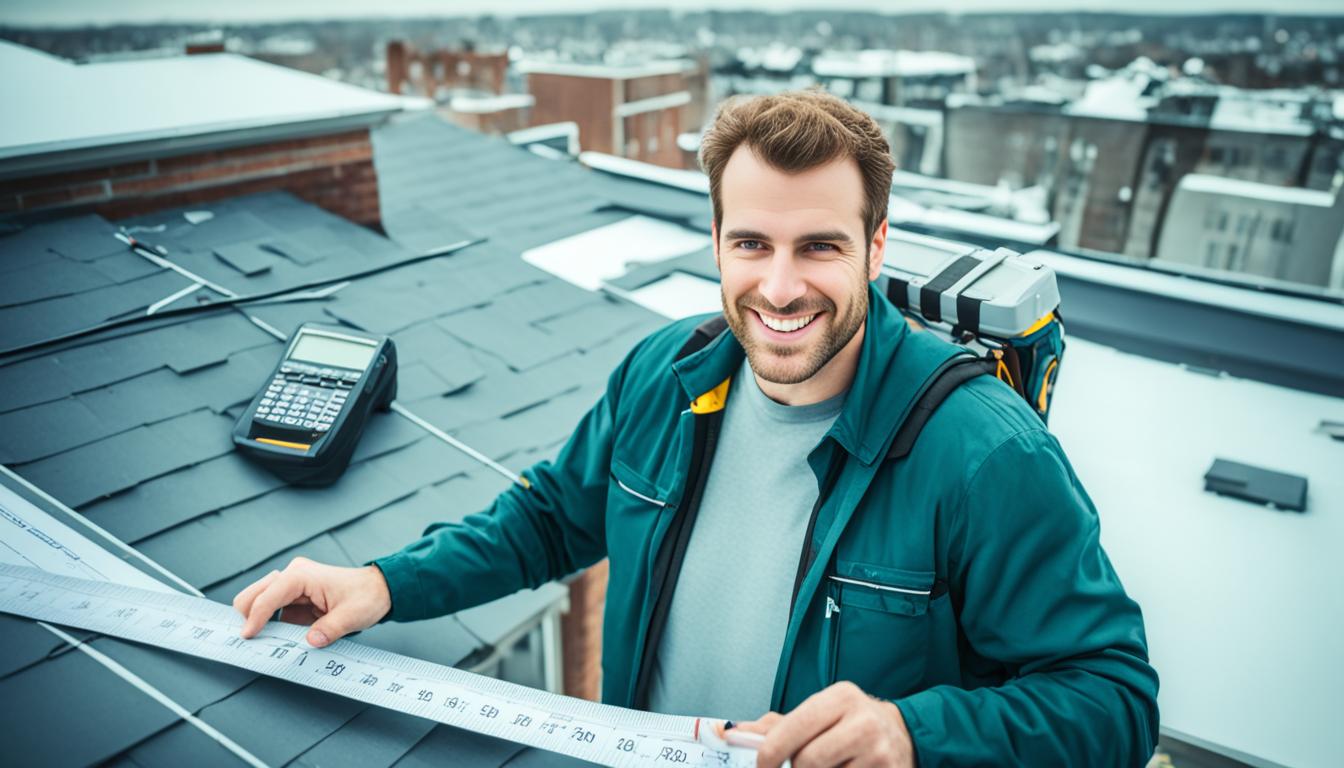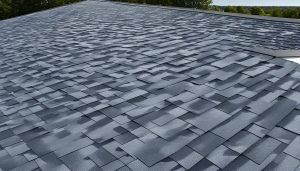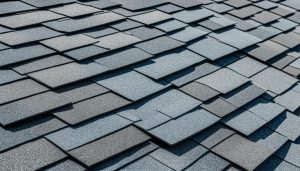Welcome to our comprehensive guide on how to calculate roof square footage. Whether you are embarking on a renovation project or planning new construction, accurately determining the square footage of your roof is essential for materials estimation and budgeting. In this article, we will walk you through the step-by-step process, providing helpful tips and insights along the way.
By following our expert guidance, you will gain the knowledge and skills to measure your roof accurately, handle different roof shapes and slopes, make necessary adjustments, and utilize tools and resources that streamline the calculation process. Let’s get started on ensuring the success of your project by calculating the roof square footage correctly.
To begin, it’s important to understand the fundamentals of measuring the roof. In the next section, we will explore various techniques for measuring both flat and pitched roofs, offering valuable advice for achieving precise results. So, let’s dive in and learn the art of measuring the roof.
Stay tuned for our upcoming sections, where we will cover calculating square footage, adjustments and considerations, tools and resources, and the importance of accuracy in roof square footage calculations. By the end of this guide, you will be equipped with everything you need to confidently calculate the roof square footage for your project needs.
Measuring the Roof
To accurately calculate the square footage of your roof, you need to start by measuring its dimensions. This involves determining the length and width of each section of the roof. Whether you have a flat or pitched roof, proper measurement is key to obtaining precise calculations. By following the steps outlined below, you can ensure accuracy while avoiding common pitfalls:
Measuring Flat Roofs
When measuring a flat roof, begin by dividing it into sections. Measure the length and width of each section separately. To ensure accurate measurements, take multiple measurements at different points of each section. This will account for any irregularities or variations in the roof’s dimensions.
Measuring Pitched Roofs
Measuring pitched roofs requires additional considerations, as the slope and angles can affect the dimensions. Start by measuring the length and width of each section of the roof, just as you would for a flat roof. However, you must also take into account the slope or pitch of the roof.
To measure the slope, you can use a level tool or a smartphone app that has a built-in level feature. Place the level on a level surface on the roof and measure the vertical distance from the roof surface to the level. This measurement represents the rise of the roof.
Next, measure the horizontal distance from the edge of the roof to the point directly below the level. This measurement represents the run of the roof. With these measurements, you can calculate the slope using basic trigonometry.
Remember to exercise caution when measuring pitched roofs, especially when climbing ladders or accessing steep areas. Safety should always be a priority.
| Type of Roof | Measurement Technique | Tips |
|---|---|---|
| Flat Roof | Measure length and width of each section separately | – Take multiple measurements for accuracy – Account for irregularities in the roof’s dimensions |
| Pitched Roof | Measure length and width, account for slope | – Use a level tool or smartphone app to measure slope – Exercise caution when accessing steep areas |
By measuring your roof accurately and taking into account the slope, you are setting the foundation for precise square footage calculations. This will help you estimate materials and budget effectively for your roofing project.
With the roof measurements in hand, you are now ready to move on to the next step—calculating the square footage of your roof.
Calculating Square Footage
Now that you have measured the dimensions of your roof, it’s time to calculate the square footage. By following a simple formula and performing the necessary calculations, you can determine the total roof square footage for your project. Whether you are dealing with a simple or complex roof shape, this section will guide you through the process, ensuring accuracy every step of the way.
Before we dive into the calculations, it’s important to understand the significance of accurate square footage measurement. A precise calculation will help you estimate the materials required, plan your budget accordingly, and avoid any unnecessary expenses or delays.
Formulas for Common Roof Shapes
Calculating the square footage of a flat roof is relatively straightforward. Simply multiply the length by the width of the roof section to get the area in square feet. For example, if your flat roof measures 20 feet by 30 feet, the total square footage would be 600 square feet.
However, when dealing with pitched roofs or irregular shapes, the calculation becomes slightly more complex. To determine the square footage of a pitched roof, use the formula: (Length × Width) + ((Length × Rise) ÷ 2). This formula takes into account the slope of the roof, represented by the rise in inches per foot of horizontal distance.
Handling Complex Roof Shapes
In some cases, roofs may have multiple sections with different shapes, such as gables, hips, or dormers. To calculate the square footage of these complex roof shapes, break them down into individual sections and apply the appropriate formulas for each. Once you have calculated the square footage of each section, add them together to obtain the total roof square footage.
It’s important to note that accurate measurements are essential when dealing with complex roof shapes. Pay close attention to any angles or slopes and take precise measurements to ensure the calculations are as accurate as possible.
By following these steps and formulas, you can calculate the square footage of your roof with confidence. This information will be invaluable when estimating materials, budgeting for your project, and working with contractors.
Adjustments and Considerations
In the process of calculating roof square footage, there are additional adjustments and considerations that need to be taken into account. These factors play a crucial role in accurately measuring the total square footage of the roof. Let’s explore some of the key adjustments and considerations:
Accounting for Overhangs
Overhangs are areas of the roof that extend beyond the exterior walls. When measuring the roof, it’s important to include these overhangs in your calculations. These extended sections impact the overall square footage and should be accounted for to ensure accurate estimates.
Addressing Hips and Valleys
Hips and valleys are architectural features that add complexity to a roof’s structure. These areas require special attention when calculating the square footage. You’ll need to take into consideration the slope and angle of these sections to ensure precise measurements.
Accounting for Multiple Sections
In some cases, a roof may consist of multiple sections, such as different levels or additions. Each section needs to be measured separately, and their respective square footages should then be added together to get the total roof square footage. Careful measurement and accurate calculations are essential for accurate results.
Consideration for Angles
Roofs with varying angles, such as gables or dormers, require special consideration during measurements. It’s important to account for the angle of these sections when calculating the square footage, as they significantly impact the overall roof area. Accuracy is key to avoid material shortages or overestimations.
By accounting for overhangs, hips, valleys, multiple sections, and angles, you can ensure precise calculations of your roof square footage. These adjustments and considerations are essential for accurate material estimation and budgeting.

Tools and Resources
When it comes to calculating roof square footage, you don’t have to rely solely on manual measurements. There are a variety of tools and resources available that can make the process much easier and more efficient.
Smartphone apps: Utilizing smartphone apps can be a game-changer in your roof measurement endeavors. These apps allow you to take measurements directly from your phone, eliminating the need for manual calculations. Some apps even offer augmented reality features, allowing you to visualize the roof measurements in real-time.
Online calculators: Online calculators are a convenient way to calculate square footage without the need for complex formulas. These tools typically require you to input the dimensions of your roof, and they will instantly provide you with the square footage. Online calculators are easily accessible and can save you valuable time and effort.
Aerial imagery: Aerial imagery, such as satellite images or drone footage, can provide a bird’s-eye view of your roof. These images can be used to measure the dimensions of your roof accurately. By leveraging aerial imagery, you can get a comprehensive overview of your roof’s layout and easily determine the square footage.
Integrating these tools and resources into your roof square footage calculations can streamline the process and improve accuracy. Whether you prefer using smartphone apps, online calculators, or aerial imagery, these resources are valuable assets in ensuring a precise measurement of your roof.
Remember, accurate roof square footage is vital for materials estimation, budgeting, and successful project planning. By utilizing these tools and resources, you can expedite the measurement process and confidently move forward with your roofing project.
Importance of Accurate Roof Square Footage
When it comes to any roofing project, accuracy is key. Knowing the exact square footage of your roof is essential for a successful construction or renovation endeavor. In this section, we will highlight the significance of obtaining precise measurements and calculations and the potential consequences of inaccuracies.
The Impact of Inaccurate Measurements
An inaccurate measurement of your roof’s square footage can have detrimental effects on your entire project. Let’s explore some of the critical repercussions:
- Material Shortages: By underestimating the roof square footage, you risk ordering insufficient materials, which can significantly delay your project and increase costs.
- Budget Overruns: Inaccurate measurements can lead to budget overruns due to unexpected expenses for additional materials and labor required to remedy the errors.
- Project Delays: Incorrect measurements can cause significant delays in the construction or renovation process. This can disrupt timelines and affect the overall project schedule.
As you can see, the repercussions of inaccurate measurements extend beyond simple miscalculations. Let’s delve into how precise calculations can positively impact your roofing estimates and contractor bids.
The Benefits of Accurate Calculations
Obtaining accurate roof square footage offers a multitude of advantages that can enhance the efficiency and success of your project:
- Precise Material Estimation: Accurate calculations enable you to order the correct amount of roofing materials, minimizing wastage and ensuring cost-effectiveness.
- Accurate Budgeting: Knowing the exact square footage helps you create an accurate budget, avoiding unexpected financial setbacks and allowing for better financial planning.
- Informed Decision Making: Accurate measurements empower you to make informed decisions about your roofing project, including selecting the most suitable materials and hiring the right contractors.
- Precise Contractor Bids: When soliciting bids from roofing contractors, providing an accurate roof square footage ensures that you receive accurate and competitive proposals, preventing potential disputes or misunderstandings.
Image related to the Importance of Accurate Roof Square Footage:
By emphasizing the significance of obtaining accurate roof square footage, you can set the stage for a successful roofing project. Accurate measurements and calculations reduce the risk of material shortages, budget overruns, and delays while facilitating informed decision-making and precise contractor bids. Now that we understand the importance, let’s explore some additional tips and considerations to ensure accurate calculations in the next section.
Conclusion
With the step-by-step guide provided in this article, you now have the knowledge and tools to confidently calculate the square footage of your roof for any renovation or construction project. Accurate measurements and calculations are essential for making informed decisions, avoiding costly mistakes, and ensuring a smooth roofing process.
By accurately calculating the roof square footage, you can estimate the materials needed more precisely, plan your budget effectively, and streamline the entire project. Whether you have a flat or pitched roof, this guide has covered the measurements and calculations needed for any roof shape or slope.
Now that you understand the importance of precise measurements, put your knowledge into action and start calculating your roof square footage today. Stay on top of your project’s requirements, eliminate guesswork, and save both time and money by employing the techniques and resources outlined in this article. Remember, a well-measured roof leads to a successful construction project.




